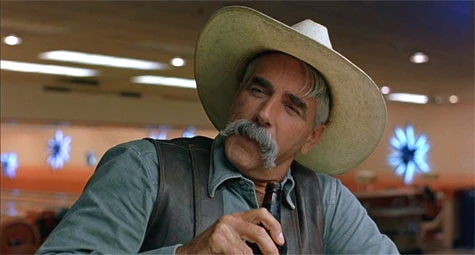 |
| Fig 1. |
"The Big Lebowski" (1998) dir. Joel & Ethan Coen, centers on "The Dude" or Jeff Lebowski, a character that isn't so much the hero but rather, as Sam Elliot's Narrator puts it, someone who's there. His life consists of hanging out with his friends (Donny and Walter) at the bowling alley, drinking "White Russians" and enjoying his lackadaisical existence. Hired goons break into his house and mistake him for another Jeff Lebowski; a richer and far better off man that shares nothing but the name with his worser off namesake. The film is a pastiche on 1940's Film Noir, in that it parallels its tropes and structure, even going so far as to to share a similar name with one of its influences "The Big Sleep" (1946).
 |
| Fig 2. |
 |
| Fig 3. |
Act 2, The rising action concerns the thickening of the mystery. The Dude is contacted by 'Big' relaying the information that his wife is missing, then asking him to do him a favor by delivering ransom money to the kidnappers via a drop at a midnight meet. He takes Walter with him, who suggests they deliver a 'Ringer' instead, this being a suitcase full of dirty underwear instead of the supposed million dollar ransom bestowed into their care by 'Big'. Delivering the ringer to the kidnappers, they return home, only for The Dude's car - and the real ransom - to be stolen later that evening. Following on from this, The Dude seeks to find his car, encounters German Nihilists that are linked to Bunny via the porn industry, working under Jackie Treehorn, whom it is purported that Bunny Lebowski owes money to.
Act 3, The climax of the film melds the main plot and the B-plot where The Dude receives the revelation from Maude that her father has no real wealth, leading to his realisation that the whole plot was a fabrication of the 'Big' Lebowski, who, seeing that his wife had left, took the opportunity to extort money from his charity foundation. This harkens back to the inciting incident wherein the true nature of 'Big' is finally revealed; The thugs looking for money at the start of the film ultimately wouldn't have found any had they robbed the correct Lebowski, who in turn is revealed to be a crook himself.
Act 4, The falling action concerns the confrontation between The Dude, Donny, Walter and the Nihilists, who it is revealed never kidnapped Bunny, and thus were exploiting her status as missing in order to extort money from 'Big' Lebowski. The Dude informs them that he knows that Bunny has returned from her road trip, and thus their ruse is foiled, but during the confrontation, Donny suffers a heart attack and dies. After this, Walter and The Dude scatter his ashes and end up bickering when wind blows Donny's ashes into The Dude's face. Of Donny and his effect on the plot, William Robert Rich, writing for Screenplayhowto.com says "He fights off Nihilists with The Dude and Walter, only to die of a heart attack after the altercation. His funeral takes up over half of the epilogue. All that, and Donny’s total significance to the plot equals zero. You could take Donny out and it would still be the same story, but it wouldn’t be the same movie." (Rich, 2011) And it is again, this sense of the unimportant that permeates not only The Dude's story, but that of his supporting cast, in fact, most of the events herein.
 |
| Fig 4. |
It is interesting to note that under the hood, "The Big Lebowski" has a pretty standard structure, though it is one that is made elusive by the Coen's insistence to muddy the waters of the plot by focusing on the unimportant, the mundane and the inconsequential. This is a technique of theirs that really instills their work with their own distinctive flavour, and it is a refreshing notion to experience a film that revels in the unimportance of the events it shows us. In that respect, It can be said that this experimentation is succesful, and as fandom surrounding the film would suggest a wholly enjoyable affair.
Bibliography
The Coen Brothers, The Big Lebowski. 1998. DVD.
Hinkson, Jake "The Noir Geek’s Guide to The Big Lebowski" CriminalElement.com [Online] http://www.criminalelement.com/blogs/2014/09/the-noir-geeks-guide-to-the-big-lebowski-coen-brothers-jake-hinkson [Accessed on 19/10/2016]
Rich, William Robert "The Big Lebowski" Screenplayhowto.com [Online] http://screenplayhowto.com/screenplay-analysis/the-big-lebowski-analysis/ [Accessed on 19/10/2016]
Illustrations
Fig 1. The Big Lebowski Poster. [image] Available at: https://s-media-cache-ak0.pinimg.com/originals/66/fa/2e/66fa2e758f84343957c0b3240c5d8989.jpg [Accessed 19/10/2016]
Fig 2. The Dude. [image] Available at: http://cdn.hitfix.com/photos/6082455/big-lebowski-the-dude-smiling_article_story_large.jpg [Accessed 19/10/2016]
Fig 3. The Narrator. [image] Available at: http://vignette2.wikia.nocookie.net/thebiglebowski/images/5/5b/The_stranger_2.jpg/revision/latest?cb=20111216192623 [Accessed 19/10/2016]
Fig 4. The Gang. [image] Available at: http://images.mentalfloss.com/sites/default/files/styles/article_640x430/public/587698547.png [Accessed 19/10/2016]

No comments:
Post a Comment